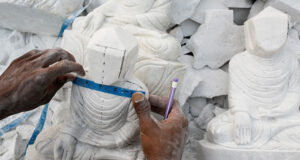


In the bustling streets of Jaipur, the Pink City of India, lies a rich tradition of craftsmanship that has flourished for centuries—the art of sculpting marble moortis, or sacred statues. Renowned for their exquisite beauty, intricate detailing, and spiritual significance, Jaipur’s marble moortis are celebrated as masterpieces of artistry and devotion. In this article, we delve into the craftsmanship behind Jaipur’s marble moortis, exploring the techniques, traditions, and spiritual significance that make them revered by devotees and art connoisseurs alike.
1. Legacy of Artistry:
The art of sculpting marble moortis in Jaipur traces its roots back to the Mughal era, when skilled artisans were commissioned to create exquisite works of art for palaces, temples, and royal residences. Over the centuries, this tradition evolved and flourished, with Jaipur emerging as a leading center for marble craftsmanship in India. Today, the city is home to a vibrant community of artisans who continue to uphold this rich legacy of artistry and craftsmanship.
2. Sacred Traditions:
The creation of marble moortis in Jaipur is steeped in sacred traditions and rituals that have been passed down through generations of artisans. Before beginning work on a new sculpture, artisans often perform puja, or ritual worship, to invoke divine blessings and seek the guidance of the gods and goddesses. This spiritual connection infuses their work with a sense of reverence and devotion, transforming each sculpture into a sacred embodiment of the divine.
3. Meticulous Techniques:
Crafting a marble moorti is a labor-intensive process that requires skill, precision, and patience. Artisans begin by selecting the finest quality marble blocks, sourced from quarries in Rajasthan and beyond. Using traditional hand tools and techniques, they chisel, carve, and sculpt the marble with meticulous care, bringing the divine forms to life with exquisite detail and precision.
Each stage of the process requires a delicate balance of artistry and craftsmanship, as artisans strive to capture the essence and beauty of the divine beings they depict. From the graceful curves of a goddess’s form to the intricate patterns of a deity’s attire, every aspect of the sculpture is meticulously crafted to perfection, resulting in a masterpiece of artistry and devotion.
4. Spiritual Significance:
Marble moortis hold profound spiritual significance in Hindu culture and tradition. They serve as physical representations of the divine beings worshipped by devotees, providing a tangible focal point for spiritual devotion and reverence. The presence of a marble moorti in a home or temple is believed to invite the blessings and grace of the gods and goddesses, fostering a sacred atmosphere of peace, harmony, and spiritual upliftment.
5. Preserving Heritage:
In addition to their spiritual significance, Jaipur’s marble moortis are also valued as cultural treasures and works of art. Many artisans in Jaipur are dedicated to preserving and promoting this rich heritage of craftsmanship, passing down their skills and knowledge to future generations. By continuing to create exquisite marble moortis that honor traditional techniques and designs, these artisans ensure that Jaipur’s legacy of artistry and devotion will endure for generations to come.
Conclusion:
In conclusion, the craftsmanship behind Jaipur’s marble moortis is a testament to the rich tradition of artistry and devotion that has flourished in the Pink City for centuries. Through meticulous techniques, sacred traditions, and profound spiritual significance, artisans in Jaipur create exquisite works of art that inspire devotion, reverence, and awe. As guardians of this rich heritage, they continue to uphold the legacy of craftsmanship that has made Jaipur synonymous with beauty, culture, and spirituality.



